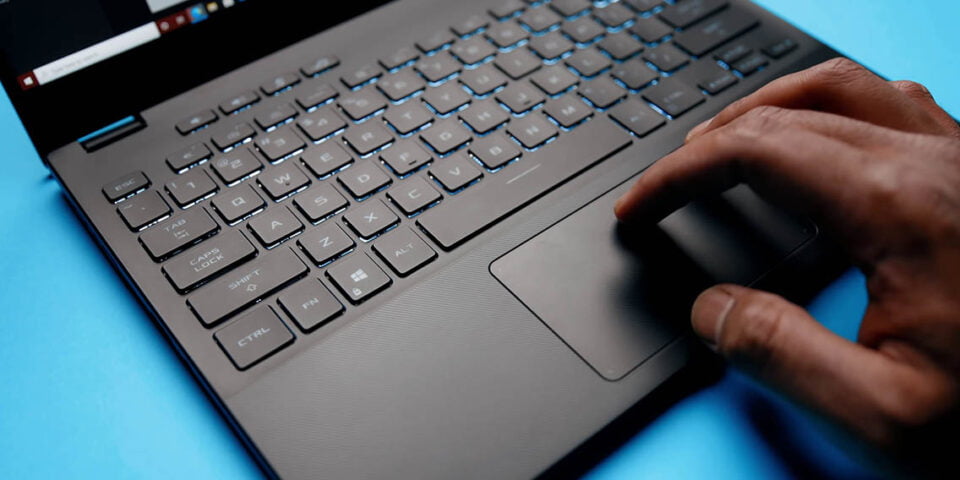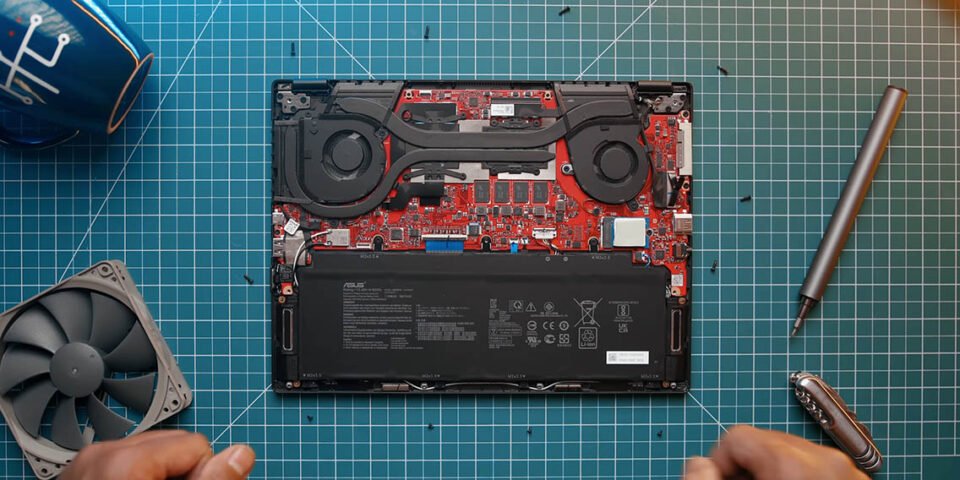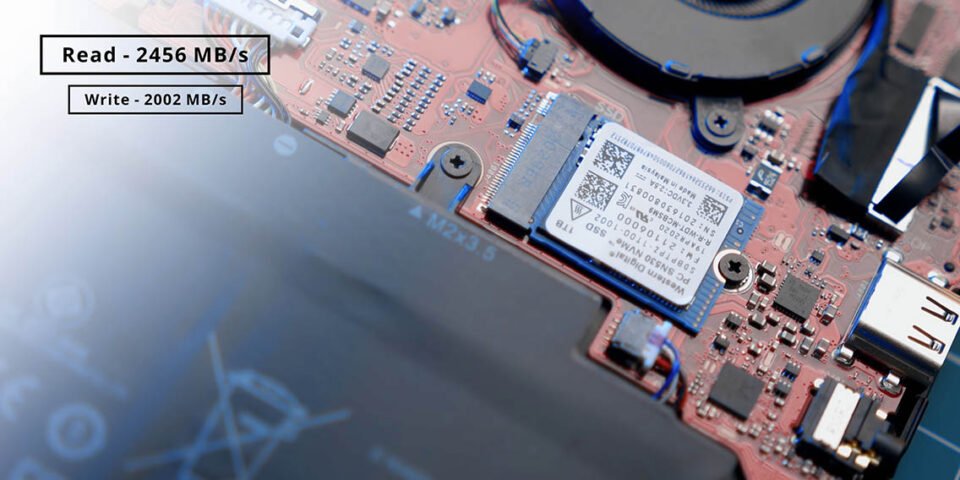
This Gaming Laptop Does EVERYTHING!
2021-07-07Table of contents
You’ve seen a 2-in-1 laptop before, you know the one that switches between laptop mode and tablet mode when you tilt the screen 180 degrees around. Well what happens when you add a little bit of gaming DNA to that? That is the ROG Flow X13, a device that takes everything about portable gaming to a whole new level.
ASUS was able to do this by introducing an ecosystem that basically allows you to expand your performance profile to something unique that you wouldn’t necessarily be able to achieve with a traditional ultrabook and a GPU dock via Thunderbolt. In fact, we have made a separate video discussing that setup and its complexities, which you can check out right over here.
Now the Flow X13 has one of the fastest processors on the planet, a GPU that is good enough to game wherever you go, and if you need a lot of power you can hook up an RTX 3080 via this portable mobile dock called the XG Mobile. The best part is that it’s so seamless to a point where you don’t have to worry about drivers or restarting the system, or just fiddling around with different issues that you might experience with a Thunderbolt dock. It just works, and I’m super excited to talk about my experience, but also mention some of the concerns.
Models & Prices
Let’s start off with the Flow X13 portable gaming ultrabook. It is meant to compete against something like the Razer Blade Stealth 13. The specs inside this device might give the Blade a run for its money, because it has AMD’s Ryzen 9 5980HS processor with 8 cores and 16 threads. Keep in mind that we have the SuperNova Edition that unfortunately you can’t actually buy at the moment, but the standard edition comes with the 5900HS CPU. The rest of the specs are pretty much identical: 16GB of RAM, 1TB NVMe SSD, 120Hz 1200P display, GTX 1650, all for $1,500 USD. Now the sample that we have over here has twice the memory, and a 60Hz 4K display. Unfortunately, I’m not sure what pricing is for this particular variant, but something to keep in mind is that this device just goes out of stock every time and ASUS is trying to restock it every other day. I did check it this morning and it was in stock, but when you are probably watching this it might be out of stock. It’s just the current scarcity situation that makes it really tough to buy this device. Make sure you constantly check the website and you might get lucky.
As for the XG Mobile, with the RTX 3080 GPU you are looking at an additional $1500 USD, which in total would cost you about $3000 USD with the Flow X13 and that’s a lot of money. But if you do plan on buying them as a bundle you will save about $200, which is a pretty good deal in my opinion… if you do find them in stock.
Now if you look at the overall design of the X13, ASUS has done a nice job keeping it stealth with the exterior and interior. The top lid comes with these textured lines across a surface that gives the user a little bit of grip to hold onto when traveling. It also does a great job resisting fingerprints, and the hinge is pretty strong for a 2-in-1 device. It exhibits a little bit of wobble, but it’s nothing to be worried about.
Keyboard & Trackpad
The interior space follows the same design language as the exterior. I like the matte black texture and the keyboard layout is pretty standard given the size. You get extra buttons to access Armoury Crate, control the volume levels, and mute the microphone. The keys themselves are excellent, it actually reminded me of the Zephyrus G15 that I looked at recently. Key travel is adequate for those who type a lot and it’s just a very satisfying feel when you bottom out. They are LED backlit in white, which is an odd choice to be honest, because typically with ROG laptops ASUS just loves to throw in AURA RGB lighting. However, I do wish it got brighter.
The trackpad is decent, it’s not the smoothest surface that I worked on especially compared to the Razer Blade Stealth 13, and it’s pretty small too, but I will say that the integrated primary left/right buttons sound excellent, nice and tactile. Something else that I should mention is that this trackpad picks up finger oil easily, so you will have to constantly remind yourself to clean it once in a while if you like to keep your devices clean.
Overall from a build quality standpoint, ASUS has done a really good job with the Flow X13. There were no signs of creaking within the chassis given that it is made out of magnesium alloy instead of an all aluminium construction. It’s also lighter than the Blade Stealth 13 coming in at just under 3 pounds. And it’s only 0.62 inches thick so it’s very convenient to travel with.
This is the webcam test on the Flow X13 by ROG. What is really interesting is that this one of the first laptops from ROG in a really long time to feature a webcam. The video quality is pretty good, and the microphone sounds pretty good as well. The fact that we get a webcam at all is kind of nice. The speakers are located at the bottom, so naturally you will compromise on audio fidelity, especially with the trebles. There is a little bit of bass, but it’s nothing mind blowing. Overall it gets the job done for the form factor.
The Display
The X13 comes with a 4K IPS 60Hz display, and given that it has a 16×10 aspect ratio you get some more vertical screen real estate to work. The quality of this panel is great. From my display analysis tests it covers 99% sRGB, 80% Adobe RGB, and 86% DCI-P3, so it’s great for editing photos and maybe a little bit of content creation given that it has a discrete GPU. Brightness levels are respectable, but it only peaks to about 390 nits. This display is covered with Corning Gorilla Glass, which interestingly does a pretty good job cutting out a lot of the reflections, especially in extremely bright environments, which is really cool.
Let’s not forget this is a 2-in-1 device so you can use this in tablet mode and interact with the content in a more lively manner. Plus it also features touch support, so you can use the included stylus to jot down notes or doodle around if that’s something that you’re into. One thing I would strongly recommend is that you pick the 120Hz 1200P display over the 4K 60Hz option simply because gaming at 60Hz is an eyesore, especially in 2021. Also the GTX 1650 inside this laptop isn’t powerful enough to drive modern games at that 4K resolution, and you save a lot of money too.
Connectivity
Port selection unfortunately is very limited on the X13. As you can see on the right-hand side there is a USB Type-C 3.2 Gen2 port that supports PD charging and it supports DisplayPort output. There is also a full-size USB Type-A Gen2 port and a power button, which also acts as a fingerprint reader. Switching over to the other side you will see another USB-C port and a little silicone cover that covers the proprietary jack for the XG Mobile. This cover can be easily misplaced, so it’s something to keep track of. Next to that is an HDMI 2.0b port and an audio jack. Now it’s not the worst setup that I have come across, but if you need to connect other peripherals or external accessories you will need to invest in a hub.
However, if you do end up picking up the XG Mobile you just automatically get access to a bunch of ports, four USB Type-A ports, one extra HDMI 2.0b port, a full-size DisplayPort, an RJ45 jack, and a UHS-III full-sized card reader. Bravo ASUS, you really have thought about implementing the best ports in a device that is a lot smaller than external GPU docks.
XG Mobile Setup
Speaking of the XG Mobile, it’s a pretty compact module that can easily carried over from one place to another. The build quality is not the greatest and it’s mostly made of plastic components. It stands up on the desk through a built-in kickstand that is integrated within the unit. Keep in mind that once you have this plugged into the Flow X13 it actually passes power to the laptops, so there is no need to connect the power cable that comes with the laptop separately. That clears an extra USB Type-C port on the side, which is nice.
Setting it up is super simple, and ASUS has actually put a lot of thought into this. First you need to plug in the power cable to the dock, then you plug in the proprietary connector to the X13, and then you lock it with the switch located on top. You will then get a pop-up notification asking whether or not you want to connect the XG Mobile to the X13. Once you click okay you just have to wait for about a minute and then you are good to go. Just make sure you deactivate the device by clicking the icon tray on your task bar before unplugging the connector.
It’s just crazy to think how much power you can get from such a compact setup, because it’s significantly smaller in size compared to some of the other external GPU docks that I have taken a look at. However, there are a few issues that I did run into. First up randomly my external drives just won’t be recognized, especially storage devices. Other times the video output wouldn’t be detected if the peripheral is plugged in. Then there is the magnet for the kickstand that got pushed out of the chassis and it’s now sitting on the inside flap. And finally, I noticed that the laptop just wouldn’t go to sleep when you have this thing plugged in. To be honest, I was expecting some quirks to come with this first generation product, so all of this is not unexpected.
I do want to spend some time and talk about the future of this ecosystem, because this is a cool product and it’s a great start. It’s very unique, but I’m not sure if ASUS is going to support this in the future. Are they going to roll out an updated Flow X13 with faster CPU or faster specs? Are they going to roll out an XG Mobile with the RTX 4080 if NVIDIA launches that later on? These are some of the questions that are up in the air, and like I said I really hope they take this idea and build upon that foundation. I wouldn’t invest in this ecosystem in the hopes of upgrading down the future because there is just no guarantee, and that is just something to keep note of.
Insides & SSD Performance
Upgradability on the Flow X13 is pretty restricted. As you can see the memory is soldered onto the PCB, and the only component that is user upgradable is the M.2 NVMe SSD. This drive is an M.2 2230 spec, so you can’t actually swap it out for the standard 2280 spec. The drive speeds are okay, it’s not the fastest that I’ve seen, but it will get the job done.
Now what about battery life? Well remember the Flow 13 is a slim-and-light laptop, but it also houses one of the most powerful mobile processors, but it also has a pretty small battery compared to a lot of the other laptops we have seen from ASUS at just 60Wh so there has definitely been some tradeoffs. As you can see while about 10.5 hours is pretty good, it doesn’t actually come anywhere close to what some of the other modern gaming laptops are able to deliver. It’s also pretty low for a thin-and-light notebook as well. Under a heavier load this laptop only lasts just a little over 2 hours, even though the Ryzen 9 5980HS gets down clocked to a much lower power level. It would be really interesting to see how these standard 5900HS model does here, since that one is supposed to be operating at a bit lower power.
And speaking of power levels, I need to set the stage for you a little bit because this one’s going to be an odd one. But it also highlights the problems that we are facing with the laptop market right now. The main issue is that performance isn’t necessarily determined by the name of the CPU anymore, because it all comes down to how much power a laptop funnels to the processor and how it’s cooled. For example, a Ryzen 9 5900HS running at 45W will typically be able to sustain better frequencies than a 5980HS running at just 40W. You might pay a little bit more for the faster/ the higher spec CPU, but that won’t necessarily give you better performance. So let’s see how this all translates into the Flow X13 and compare it to the 5900HS in ASUS’s own Zephyrus G15.
CPU Power / Temperatures / Frequency
Temperatures are actually quite well managed here, at least in Performance Mode where the CPU barely gets above 80°C. However, there is a dip at the 6 minute Mark and you will see why soon. On the other hand Turbo Mode sees a gradual increase to the point where things get pretty toasty, but still very short of AMD’s throttle temperature of 105°C. Adding the G15 here really gives another perspective since it’s Performance Mode pegs temperatures above 90°C for a few minutes, and then normalized down to a more reasonable point. You can actually see how power modulation in all 3 modes pretty much directly lines up with the dips in temperature. Performance Mode only pushes the 5980HS to 42W after which it gets tugged all the way back down to 35W, while Turbo Mode gives it a bit more juice to work with. And when you add the G15’s 5900HS you will see what I was talking about just a few seconds ago. Even in performance mode it’s allowed to chug down a lot more power than the Flow X13’s 5900HS and it keeps a really, really constant level all the way towards the end of the test.
And all of that translates into some really interesting clock speed comparisons, where we can literally see the effect of power on the Flow X13’s overall performance. A dip in power means lower clocks, it’s just as simple as that, but with the G15 it basically just overtakes the Flow when it comes to frequencies during an all-core load. That leads the 5900HS walking all over the 5980HS in many situations. Look I know I’m comparing a thin-and-light laptop to something that is thicker, but it’s an important element when it comes to making that purchasing decision, because it highlights why you shouldn’t assume a higher end CPU or GPU will get you better performance, especially on laptops. There are just a lot more variables than that.
Real-World Performance
Now let’s just see how all of these overtime results translate to real-world benchmarks. And as we go through these, you will notice that just like the clock speeds suggested, the 5980HS in the Flow X13 just can’t keep up with the 5900HS G15 in multi-core loads, but then again it isn’t meant to either. As a matter of fact this is the fastest thin-and-light laptop we have tested by a long shot. I should also mention that the 5900HS version will probably be just as fast since ASUS is running it at the same power limits.
Moving on to programs that use the CPU and GPU for acceleration, and of course the X13 with its external dock is seriously powerful. Not only that, but the CPU’s strong single-threaded performance can flex its muscles here as well. Now what isn’t being flexed is the GTX 1650, especially in DaVinci Resolve. It just doesn’t have the horsepower to keep up with the faster GPU’s here, but it still gets the job done.
GPU Power / Temperatures / Frequency
But I think the biggest selling point of this laptop is the external GPU dock. It just allows the X13 to be super mobile, but also have access to that extra horsepower with the ability to game at super high levels when you have this thing plugged in. Not only that, but the space within the XG dock allows ASUS to run the RTX 3080 mobile GPU near its maximum power limit in Turbo Mode and all the way up to 120W in Performance Mode. Clock speeds are right up there too, and are way higher than any other notebook-based 3080 I’ve seen so far. I just wish we could control the Performance Mode of the external dock separately from the laptops, since it would allow for a much more adaptable experience. The only exception is Silent Mode, which starts off pretty well, but then it gets pounded as it starts to throttle. Temperatures are really well managed too, without anything to worry about, but I guess that is expected since ASUS didn’t need to work within the typical laptop thermal constraints here.
Gaming Performance
As for gaming performance, well first of all the GTX 1650 really isn’t designed for this type of gaming, but it still delivers some playable frame rates. The only reason it fails in some games is its 4GB of memory just isn’t enough for our settings. The RTX 3080 external card results need a bit of explanation since those results are a bit all over the place. At least at 1080P a lot of the variations seem to be due to CPU bottlenecks, because in the games where GPU horsepower matters it just flies. You can actually see this in the 1440P results where the Flow X13 + external dock walks all over the Zephyrus G15. This is getting near high-end desktop performance levels. 4K pushes things even further, and just to give you a little bit of an idea some of these results are within just 15% of our main test system with a Ryzen 9 5900X and an RTX 3070, that’s just crazy.
Acoustics & Temps
As for acoustic performance, the X13 by itself is pretty silent, but when you factor in the XG Mobile with the RTX 3080 it does tend to get really loud and surface temperatures on both units are tolerable. Just watch out for the exhaust area on the XG mobile since it’s practically a mini-heater when you put it under load.
Conclusion
So here are my final thoughts for the ROG Flow X13. For $1500 this laptop by itself is a great value, especially when you consider what you’re getting and what you’re up against. While our sample has the Ryzen 5980HS, even you got one with the 5900HS it still has one of the fastest mobile processors on the market for this form factor.
You also get great build quality, decent battery life, and it gets a job done for gaming. In a lot of ways this is like the Razer Blade Stealth 13, but with a much better CPU and a lower price. This is a really good thin-and-light laptop itself, but when you link it up to the external RTX 3080 it just flies. At high resolutions this things just flies. I mean when you connect this thing to a secondary display you just get incredible frame rates, and the fact that you get additional I/O is just the icing on top of the cake.
But here’s a question? Would I buy the ROG Flow X13 alone when you factor out the XG Mobile? Well I’m still on the fence about that. I mean sure this thing is a really good thin-and-light laptop, but it does have some connectivity limitations, especially when it comes to ports. And there are some serious questions about how long would ASUS actually end up supporting this ecosystem because it’s a proprietary connector and I’m not exactly sure if they’re going to discontinue this after this year or maybe they might update it, it’s just a big question mark and I don’t know where to take it from there. So like I said it’s a great start, it’s very unique, and you know when you spend about $3000 for this entire year setup it’s pricey, but it is geared towards a very specific niche market. I really respect ASUS for trying something new.




















